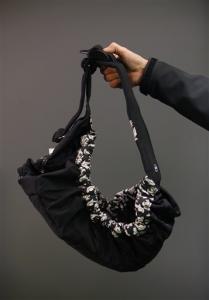 Baby-wearing is all the rage in certain mommy circles and is looked on as yet another sanctimonious trend in others.
Baby-wearing is all the rage in certain mommy circles and is looked on as yet another sanctimonious trend in others.
As it turns out, not all baby slings are created equal. The Consumer Product Safety Commission warned Friday that some of those chic baby slings can be dangerous, even deadly for their little ones.
In researching incident reports from the past 20 years, CPSC identified and is investigating at least 14 deaths associated with sling-style infant carriers, including three in 2009. Twelve of the deaths involved babies younger than four months of age.
The commission is advising parents and caregivers to be cautious when using infant slings for babies younger than four months. It said that many of the babies who died in slings were a low birth weight twin, were born prematurely, or had a cold.
According to the warning, slings can pose two different types of suffocation hazards to babies:
- In the first few months of life, babies cannot control their heads because of weak neck muscles. The sling’s fabric can press against an infant’s nose and mouth, blocking the baby’s breathing and rapidly suffocating a baby within a minute or two.
- Additionally, where a sling keeps the infant in a curled position bending the chin toward the chest, the airways can be restricted, limiting the oxygen supply. The baby will not be able to cry for help and can slowly suffocate.
Slings are made of soft fabrics that wrap around the chest so that on-the-go parents can carry their babies or just stay close as they bond with their infants. They have become increasingly popular in recent years with parents who want to “wear” their babies, known as “baby wearing”.
Slings also have been promoted by baby experts as a way to calm fussy babies or for nursing moms who can breast-feed their little ones in the sling.
The popular “SlingRider” by Infantino has been singled out for criticism because of the curved position that the baby can fall into while inside the sling.
CPSC Guide to Sling Positions:



